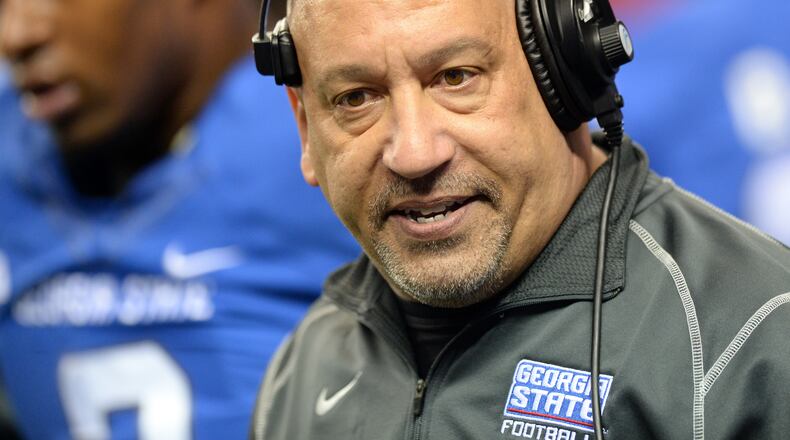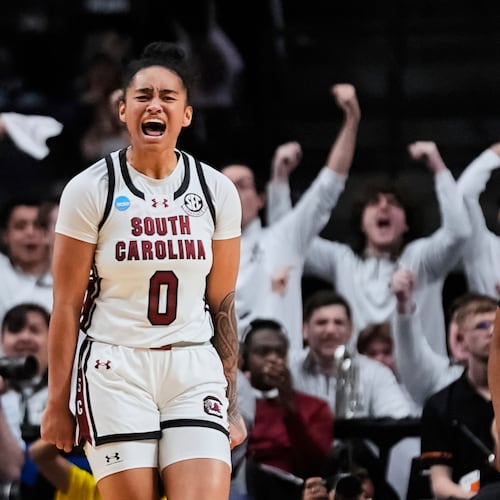Georgia State athletic director Charlie Cobb fired football coach Trent Miles after Saturday’s 37-23 loss to Louisiana-Monroe at the Georgia Dome.
Texts or voicemails to Cobb and Miles haven’t been returned.
Miles won’t coach the team’s final two games against Georgia Southern and at Idaho.
The Panthers were 2-8 this season despite returning nine starters on defense and six on offense from a team that went 6-7 last season and appeared in its first bowl game.
Miles went 9-38 overall at Georgia State.
Saturday’s loss was an example of the troubles that Miles had at Georgia State, particularly in the last two years when he started to gain some traction. The defense played well in the first half until collapsing in the second half. The offense struggled in the first half until exploding in the second half. The special teams were a mess throughout . The announced attendance was 13,106, which doesn’t reflect the actual (typically fewer) number of people at the game.
Miles was never able to get all three units to play consistently well at the same time in his three-plus seasons, other than a four-game winning streak last season.
Miles was hired by previous athletic director Cheryl Levick and replaced the retired Bill Curry in December 2012 and was seen as the man to guide the Panthers from the FCS level to the FBS based upon his track record at rebuilding his alma mater, Indiana State. The Sycamores were arguably the worst Division I program when Miles took over in 2008 before leading them to a winning record in 2010. Two more winning records followed before he joined the Panthers.
Miles did some research into Georgia State but was still surprised by the lack of resources devoted to the program compared to the schools he was recruiting against. The team shared a strength and conditioning center with every other team, a problem that was rectified in September 2015 with the opening of a facility on the grounds of the practice complex at 188 MLK Drive SE. Admission standards into Georgia State are also among the toughest in the Sun Belt, limiting the pool of players Miles could draw from. Those were a few of the problems, many of which have since been rectified.
Plus, Miles inherited a roster mess from Curry. The team wasn’t balanced by class or each position, meaning that the rebuilding effort would likely take years so that when a senior graduated, there would be a seasoned player reader to fill in. Miles was able to mostly accomplish that by the third year. However, while the numbers were there the talent didn’t seem to be based upon the team’s record. The coaching staff was able to develop a few high school players into consistent impactful players from its signing day classes.
To season the squad and build the roster balance, the coaching staff recruited and signed numerous junior college players. Quarterback Nick Arbuckle, who holds just about every school passing record, was one of the few who had a consistent impact.
Still, Miles and his staff pushed forward with a blueprint for the types of players he was going to recruit: smart, tough, good character and who loved the game. It became a mantra that he would recite so many times that it started to become rote. The belief helped improve team’s overall grade-point average, one of the few consistent victories Miles could claim.
Per the terms of Miles’ contract, he will be owed approximately $250,000. Cobb said he wanted to rework Miles’ contract after the team clinched an invitation to the Cure Bowl after defeating Georgia Southern in Statesboro. However, the contract wasn’t reworked as of the beginning of the summer workouts. Cobb would typically say it would be done, while Miles would say he wouldn’t know until the agency that represented him told him.
The next coach may be able to take advantage of Turner Field as a recruiting tool. The State Board of Regents recently approved the sale of the Braves’ former home to Georgia State, which plans to turn the baseball stadium into a football stadium for the 2017 season.
It should be a much better atmosphere than the cavernous and mostly empty Georgia Dome that Georgia State has played in since its first season in 2010.
About the Author
Keep Reading
The Latest
Featured



